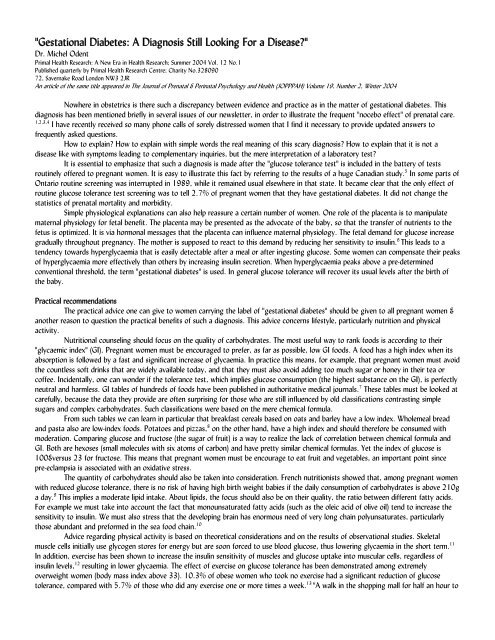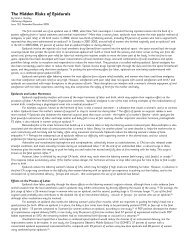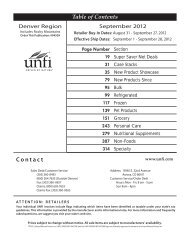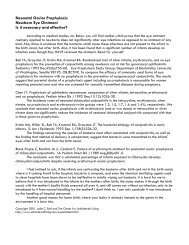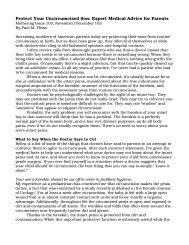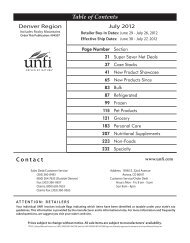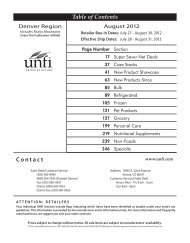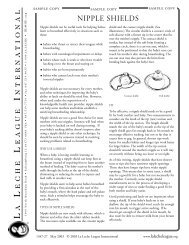"Gestational Diabetes: A Diagnosis Still Looking For a Disease?"
"Gestational Diabetes: A Diagnosis Still Looking For a Disease?"
"Gestational Diabetes: A Diagnosis Still Looking For a Disease?"
You also want an ePaper? Increase the reach of your titles
YUMPU automatically turns print PDFs into web optimized ePapers that Google loves.
"<strong>Gestational</strong> <strong>Diabetes</strong>: A <strong>Diagnosis</strong> <strong>Still</strong> <strong>Looking</strong> <strong>For</strong> a <strong>Disease</strong>"<br />
Dr. Michel Odent<br />
Primal Health Research: A New Era in Health Research; Summer 2004 Vol. 12 No.1<br />
Published quarterly by Primal Health Research Centre; Charity No.328090<br />
72, Savernake Road London NW3 2JR<br />
An article of the same title appeared in The Journal of Prenatal & Perinatal Psychology and Health (JOPPPAH) Volume 19, Number 2, Winter 2004<br />
Nowhere in obstetrics is there such a discrepancy between evidence and practice as in the matter of gestational diabetes. This<br />
diagnosis has been mentioned briefly in several issues of our newsletter, in order to illustrate the frequent "nocebo effect" of prenatal care.<br />
1,2,3,4 I have recently received so many phone calls of sorely distressed women that I find it necessary to provide updated answers to<br />
frequently asked questions.<br />
How to explain How to explain with simple words the real meaning of this scary diagnosis How to explain that it is not a<br />
disease like with symptoms leading to complementary inquiries, but the mere interpretation of a laboratory test<br />
It is essential to emphasize that such a diagnosis is made after the "glucose tolerance test" is included in the battery of tests<br />
routinely offered to pregnant women. It is easy to illustrate this fact by referring to the results of a huge Canadian study. 5 In some parts of<br />
Ontario routine screening was interrupted in 1989, while it remained usual elsewhere in that state. It became clear that the only effect of<br />
routine glucose tolerance test screening was to tell 2.7% of pregnant women that they have gestational diabetes. It did not change the<br />
statistics of prenatal mortality and morbidity.<br />
Simple physiological explanations can also help reassure a certain number of women. One role of the placenta is to manipulate<br />
maternal physiology for fetal benefit. The placenta may be presented as the advocate of the baby, so that the transfer of nutrients to the<br />
fetus is optimized. It is via hormonal messages that the placenta can influence maternal physiology. The fetal demand for glucose increase<br />
gradually throughout pregnancy. The mother is supposed to react to this demand by reducing her sensitivity to insulin. 6 This leads to a<br />
tendency towards hyperglycaemia that is easily detectable after a meal or after ingesting glucose. Some women can compensate their peaks<br />
of hyperglycaemia more effectively than others by increasing insulin secretion. When hyperglycaemia peaks above a pre-determined<br />
conventional threshold, the term "gestational diabetes" is used. In general glucose tolerance will recover its usual levels after the birth of<br />
the baby.<br />
Practical recommendations<br />
The practical advice one can give to women carrying the label of "gestational diabetes" should be given to all pregnant women &<br />
another reason to question the practical benefits of such a diagnosis. This advice concerns lifestyle, particularly nutrition and physical<br />
activity.<br />
Nutritional counseling should focus on the quality of carbohydrates. The most useful way to rank foods is according to their<br />
"glycaemic index" (GI). Pregnant women must be encouraged to prefer, as far as possible, low GI foods. A food has a high index when its<br />
absorption is followed by a fast and significant increase of glycaemia. In practice this means, for example, that pregnant women must avoid<br />
the countless soft drinks that are widely available today, and that they must also avoid adding too much sugar or honey in their tea or<br />
coffee. Incidentally, one can wonder if the tolerance test, which implies glucose consumption (the highest substance on the GI), is perfectly<br />
neutral and harmless. GI tables of hundreds of foods have been published in authoritative medical journals. 7 These tables must be looked at<br />
carefully, because the data they provide are often surprising for those who are still influenced by old classifications contrasting simple<br />
sugars and complex carbohydrates. Such classifications were based on the mere chemical formula.<br />
From such tables we can learn in particular that breakfast cereals based on oats and barley have a low index. Wholemeal bread<br />
and pasta also are low-index foods. Potatoes and pizzas, 8 on the other hand, have a high index and should therefore be consumed with<br />
moderation. Comparing glucose and fructose (the sugar of fruit) is a way to realize the lack of correlation between chemical formula and<br />
GI. Both are hexoses (small molecules with six atoms of carbon) and have pretty similar chemical formulas. Yet the index of glucose is<br />
100&versus 23 for fructose. This means that pregnant women must be encourage to eat fruit and vegetables, an important point since<br />
pre-eclampsia is associated with an oxidative stress.<br />
The quantity of carbohydrates should also be taken into consideration. French nutritionists showed that, among pregnant women<br />
with reduced glucose tolerance, there is no risk of having high birth weight babies if the daily consumption of carbohydrates is above 210g<br />
a day. 9 This implies a moderate lipid intake. About lipids, the focus should also be on their quality, the ratio between different fatty acids.<br />
<strong>For</strong> example we must take into account the fact that monounsaturated fatty acids (such as the oleic acid of olive oil) tend to increase the<br />
sensitivity to insulin. We must also stress that the developing brain has enormous need of very long chain polyunsaturates, particularly<br />
those abundant and preformed in the sea food chain. 10<br />
Advice regarding physical activity is based on theoretical considerations and on the results of observational studies. Skeletal<br />
muscle cells initially use glycogen stores for energy but are soon forced to use blood glucose, thus lowering glycaemia in the short term. 11<br />
In addition, exercise has been shown to increase the insulin sensitivity of muscles and glucose uptake into muscular cells, regardless of<br />
insulin levels, 12 resulting in lower glycaemia. The effect of exercise on glucose tolerance has been demonstrated among extremely<br />
overweight women (body mass index above 33). 10.3% of obese women who took no exercise had a significant reduction of glucose<br />
tolerance, compared with 5.7% of those who did any exercise one or more times a week. 13 "A walk in the shopping mall for half an hour to
an hour a couple of times a week is all that is needed", says author Raul Artal. According to what we currently know, the benefits of a<br />
regular physical activity in pregnancy should be a routine discussion during prenatal visits, whatever the results of sophisticated tests.<br />
<strong>Looking</strong> for a disease<br />
Almost everywhere in the world, "gestational diabetes" is a frequent diagnosis. We should therefore not be surprised by the<br />
tendency to assign it the status of a disease. This might appear as a feat, since this diagnosis is not based on any specific symptom, but<br />
just on the effects of an intervention (giving glucose) on blood biochemistry.<br />
One of the ways to transform a diagnosis into a disease is to list its complications. The well-documented fact that women<br />
carrying this label are more at risk than others to develop later on in life a non-insulin dependent diabetes has often been presented as a<br />
complication. 14 But this "type 2 diabetes" is not a consequence of reduced glucose tolerance in pregnancy. It is simply the expression, in<br />
another context, of a particular metabolic type. One might even claim that the only interest of glucose tolerance test in pregnancy is to<br />
identify a population at risk of developing a type 2 diabetes. But when a woman is looking forward to having a baby, is it the right time to<br />
bother her with glucose intake and blood samples, and to tell her that she is more at risk than others to have a future chronic disease It is<br />
probably more important to talk routinely about nutrition and exercise.<br />
<strong>Gestational</strong> hypertension has also been presented as a complication of gestational diabetes. In fact an isolated increased blood<br />
pressure in pregnancy is a transitory physiological reaction associated with good perinatal outcomes. 15, 16, 17, 18 Once more the concomitant<br />
expression of a particular metabolic type should not be confused with the evolution of a disease towards complications.<br />
Professor Jarrett, a London epidemiologist, made a synthesis of the questions inspired by such associations. He stressed that<br />
women who carry this label are, on average, older and heavier than the overall population of pregnant women, and their average blood<br />
pressure is higher. This is enough to explain differences in perinatal outcomes. The results of glucose tolerance tests are superfluous.<br />
According to Professor Jarrett, gestational diabetes is a "non-entity" . 19<br />
The concept of fetal complications is also widespread. Fetal death has long been thought to be associated with gestational<br />
diabetes. However all well-designed studies looking at comparable groups of women dismissed this belief, in populations as divers as<br />
Western European 20 or Chinese 21 , and also in Singapore 22 and Mauritius. 23 High birth weight has also been presented as a complication.<br />
In fact it should be considered an association whose expression is influenced by maternal age, parity and the degree of nutritional<br />
unbalance. If there is a cause and effect relation, it might be the other way round: a big baby requires more glucose than a small one. It is<br />
significant that in the case of twins "when the demand is double" the glucose tolerance test is more often positive than for singleton<br />
pregnancies. Only hypoglycemia of the newborn baby might be considered a complication, although there are multiple risk factors.<br />
Another way to transform a diagnosis into a disease is to establish therapeutic guidelines. Until now, no study has ever<br />
demonstrated any positive effect of a pharmacological treatment on the maternal and neonatal morbidity rates, in a population with<br />
impaired glucose tolerance. On the contrary no pharmacological particular treatment is able to reduce the risks of neonatal<br />
hypoglycaemia. 24,25 However gestational diabetes is often treated with drugs. The frequency of pharmacological treatment has even been<br />
evaluated among the fellows of the American College of Obstetricians and Gynecologists (ACOG). 26 It appears that 96% of these<br />
practitioners routinely screen for gestational diabetes. When glycaemic control is not considered acceptable, 82% prescribe insulin right<br />
away, while 13% try first glyburide, an hypoglycaemic oral drug of the sulfonylureas family.<br />
While practitioners are keen on drugs, there are more and more studies comparing the advantages of human insulin and synthetic<br />
insulins lispro and aspart, 27, 28 or comparing the effects of twice-daily regimen with four-times-daily regimen of short-acting and<br />
intermediate- actinginsulins. 29 Meanwhile the comparative advantages of several oral hypoglycaemic drugs are also evaluated. The criteria<br />
are always short- term and "glycaemic control" is the main objective. 30 The fact, for example, that sulfonylureas cross the placenta should<br />
lead to caution and to raise questions about the long-term future of children exposed to such drugs during crucial phases of their<br />
development.<br />
The nocebo effect of prenatal care<br />
After reaching the conclusion that the term "gestational diabetes" is useless, one can wonder if it is really harmless. Today we<br />
understand that our health is to a great extent shaped in the womb. 31 Furthermore we can interpret more easily the effects of maternal<br />
emotional states on the growth and development of the fetus. In the current scientific context we can therefore claim that the main<br />
preoccupation of health professionals who meet pregnant women should be to protect their emotional state. In other words the first duty<br />
of midwives, doctors and other practitioners involved in prenatal care should be to avoid any sort of "nocebo effect".<br />
There is a nocebo effect whenever a health professional does more harm than good by interfering with the belief system, the<br />
imagination or the emotional state of a patient or of a pregnant woman. The nocebo effect is inherent in conventional prenatal care, which<br />
is constantly focusing on potential problems. Every visit is an opportunity to be reminded of all the risks associated with pregnancy and<br />
delivery. The vocabulary can dramatically influence the emotional state of pregnant women. The term "gestational diabetes" is a perfect<br />
example.<br />
When analyzing the most common reasons for phone calls by anxious pregnant women, I have found that, more often than not,<br />
health professionals are ignorant of or misinterpret the medical literature, and that they lack of understanding and respect for one of the<br />
main roles of the placenta, which is to manipulate maternal physiology for fetal benefit.<br />
Prenatal care will also be much cheaper on the day when the medical and scientific literature will be better interpreted!
References:<br />
1 - Odent M. The Nocebo effect in prenatal care. Primal Heath Research Newsletter 1994; 2: 2-6.<br />
2 - Odent M. Back to the Nocebo effect. Primal Heath Research Newsletter 1995; 5 (4).<br />
3 - Odent M. Antenatal scare. Primal Heath Research Newsletter 2000; 7(4).<br />
4 - Odent M. The rise of preconceptional counselling vs the decline of medicalized care in pregnancy. Primal Health Research Newsletter<br />
2002;10(3)<br />
5 - Wen SW, Liu S, Kramer MS, et al. Impact of prenatal glucose screening on the diagnosis of gestational diabetes and on pregnancy<br />
outcomes. Am J Epidemiol 2000; 152(11): 1009-14.<br />
6 - Vambergue A, Valat AS, Dufour P, et al. Pathophysiologie du diabète gestationnel. J Gynecol Obstet Biol Reprod (Paris) 2002 ; 31(6 Suppl) :<br />
4S3-4S10.<br />
7 - Foster-Powell K, Holt SH, Brand-Miller JC. International table of glycemic index and glycemic load values. Am J Clin Nutr 2002; 76(1): 5-56.<br />
8 - Ahern JA. Exaggerated hyperglycemia after a pizza meal in well-controlled diabetics. <strong>Diabetes</strong> Care 1993; 16: 578-80.<br />
9 - Romon M, Nuttens MC, Vambergue A, et al. Higher carbohydrate intake is associated with decreased incidence of newborn macrosomia in women with gestational<br />
diabetes. J Am Diet Assoc 2001; 101(8): 897-902.<br />
10 - Odent MR, McMillan L, Kimmel T. Prenatal care and sea fish. Eur J Obstet Gynecol Biol Reprod 1996; 68: 49-51.<br />
11 - Chipkin S, Klugh S, Chasan-Taber L. Exercise and diabetes. Cardiol Clin 2001; 19: 489-505.<br />
12 - Wojtaszewski JP, Nielsen JN, Richter EA. Invited review: effect of acute exercise on insulin signaling and action in humans. J Appl Physiol<br />
2002; 93(1): 384-92.<br />
13 - Dye TD, Knox KL, Artal R, et al. Physical activity, obesity, and diabetes in pregnancy. Am J Epidemiol 1997; 146(11): 961-5.<br />
14 - Kim C, Newton R, Knopp R. <strong>Gestational</strong> diabetes and the incidence of type 2 diabetes: a systematic review. <strong>Diabetes</strong> Care 2002; 25: 1862-8<br />
15 - Symonds EM. Aetiology of pre-eclampsia: a review. J R Soc Med 1980; 73: 871-75.<br />
16 - Naeye EM. Maternal blood pressure and fetal growth. Am J Obstet Gynecol 1981; 141: 780-87.<br />
17 - Kilpatrick S. Unlike pre-eclampsia, gestational hypertension is not associated with increased neonatal and maternal morbidity except abruptio. SPO abstracts. Am J<br />
Obstet Gynecol 1995; 419: 376.<br />
18 - Curtis S, et al. Pregnancy effects of non-proteinuric gestational hypertension. SPO Abstracts. Am J Obst Gynecol 1995; 418: 376.<br />
19 - Jarrett RJ. <strong>Gestational</strong> diabetes : a non-entity BMJ1993 ; 306 : 37-38.<br />
20 - Roberts RN, Moohan JM, Foo RL, et al. Fetal outcomes in mothers with impaired glucose tolerance in pregnancy. Diabet Med 1993; 10(5): 438- 43.<br />
21 - Lao TT, Ho LF. Impaired glucose tolerance and pregnancy outcome in Chinese women with high body mass index. Hum Reprod 2000; 15(8): 1826- 9.<br />
22 - Tan Y, Yeo GS. Impaired glucose tolerance in pregnancy_is it of consequence Aust NZ J Obstet Gynaecol 1996; 36(3): 248-55.<br />
23 - Ramtoola S, Home P, Damry H, et al. <strong>Gestational</strong> impaired glucose tolerance does not increase perinatal mortality in a developing country: cohort study. BMJ<br />
2001;322: 1025-6.<br />
24 - Jensen DM, Sorensen B, Feilberg-Jorgensen N, et al. Maternal and perinatal outcomes in 143 Danish women with gestational diabetes mellitus and 143 controls with a<br />
similar risk profile. Diabet Med 2000; 17(4): 281-6.25 - Hellmuth E, Damm P, Moldted-Pederson L. Oral hypoglycaemic agents in 118 diabetic pregnancies. <strong>Diabetes</strong> Med<br />
2000; 17(7): 507-11.<br />
26- Gabbe SG, Gregory RP, Power ML, et al. Management of diabetes mellitus by obstetrician- gynecologists. Obstet Gynecol 2004; 103(6): 1229-34.<br />
27 - Jovanovic L, Ilic S, Pettitt D, et al. Metabolic and immunologic effects of insulin lispro in gestational diabetes. <strong>Diabetes</strong> Care 1999; 22: 1422-7.<br />
28 - Pettitt D, Ospina P, Kolaczynski J, et al. Comparison of an insulin analog, insulin aspart, and regular human insulin with no insulin in gestational diabetes mellitus.<br />
<strong>Diabetes</strong> Care 2003; 26(1): 183-6.<br />
29 - Nachum Z, Ben-Shlomo I, Weiner E, et al. Twice daily versus four times daily insulin regimens for diabetes in pregnancy: randomized controlled trial. BMJ 1999; 319:<br />
1223-7.<br />
30 - Langer O, Conway D, Berkus M, et al. A comparison of glyburide and insulin in women with gestational diabetes mellitus. N Engl J Med 2000; 343: 1134-8.<br />
31 -La banque de données du Primal Health Research Centre est spécialisée dans les études explorant les conséquences à long terme de ce qui se passe au début de la vie.


